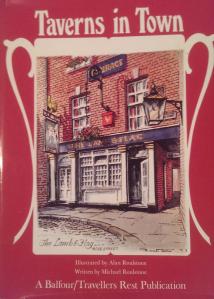Whenever I’m in a charity shop or at a car boot sale or similar I keep an eye out for books about pubs or beer. In spring 2014 I came across ‘Taverns in Town’, a charming book published back in 1973. It is an anthology of 48 of London’s best pubs with written descriptions by history and travel writer Michael Roulstone. What sets it apart though is the wonderful illustration and watercolours by his father Alan Roulstone who was well known for his drawings of pubs. According to the dust jacket of Taverns in Town, he described himself in a BBC interview as “On a pub crawl for life”. This sounds like my kind of guy!
The foreword of the book describes it as deliberately being termed an anthology because:
“A part of the reader’s enjoyment, it is hoped, will be derived from finding omissions, personal favourites that are not represented. The compilers know this full well; at the same time they are confident that their selection will meet with many nods of satisfied approval.”
This will be an argument familiar to many bloggers and people with a general interest in beer, who love to pick holes in ‘Top 10 pubs you must drink in before you die’ lists, and similar.
It is also pointed out that this is a selection of yesterday’s taverns that are also very much taverns of today (today being 1973). They come, in the main, from three distinct ages: that of Johnson (the second half of the eighteenth century), that of the regency (the early nineteenth century) and that of Dickens (mid to late nineteenth century). However, although old and interesting in their own ways, it is noted that they are also contemporary and carry out their contemporary duties in a commendable way.
This foreword got me to thinking. If these pubs had managed to survive a century or more as fine drinking establishments to be included in this book, what chance they had survived a further 40 years through the ravages of a beer market changed to be almost unrecognisable from that half a century earlier, changes in social habits, an alarming rate of pub closures and the smoking ban?
My theory is that these best of the best, highly recommended pubs ought to be the ones most able to ride out any storm and still be doing well today. A good pub is a good pub. In addition, their mainly central London locations ought to have insulated them from the worst of recession and town planning that has blighted more provincial locations.
To test my theory I am going to visit each of them (or at least the site of them if they no longer exist) to find out what became of them, find out a little of their history and write a short blog article on every one. By the end of the exercise I’ll be interested to see what proportion still rank as top class drinking houses, how many have declined and how many are no longer pubs and how this reflects local and national trends.
Given my relative infrequency of visiting London this may take me a little time – my target is to finish the task by late 2015.

Lovely. I’ll be watching this with interest.
Pingback: Taverns in Town #3: The Red Lion Tavern, Red Lion Court EC4 | Strange Brews
Pingback: Taverns in Town #4: The Essex Head (Edgar Wallace), Essex Street WC2 | Strange Brews
Pingback: Taverns in Town #6: The Black Friar, Queen Victoria Street EC4 | Strange Brews
Pingback: Golden Pints 2014 | Strange Brews
Pingback: Taverns in Town #8: Ye Olde Cheshire Cheese, Wine Office Court EC4 | Strange Brews
Pingback: Taverns in Town #9: The Flask, Highgate Village N6 | Strange Brews
Pingback: How to Beer Blog
Brilliant project!! Thank you for adding it to the Internet!! Great find here.
Pingback: Taverns in Town #17: The King’s Arms, Cheyne Walk SW10 | Strange Brews
Pingback: Taverns in Town #16: The Phoenix, Smith Street SW3 | Strange Brews